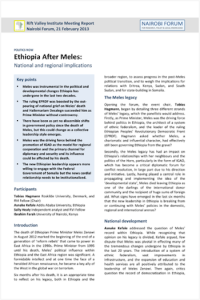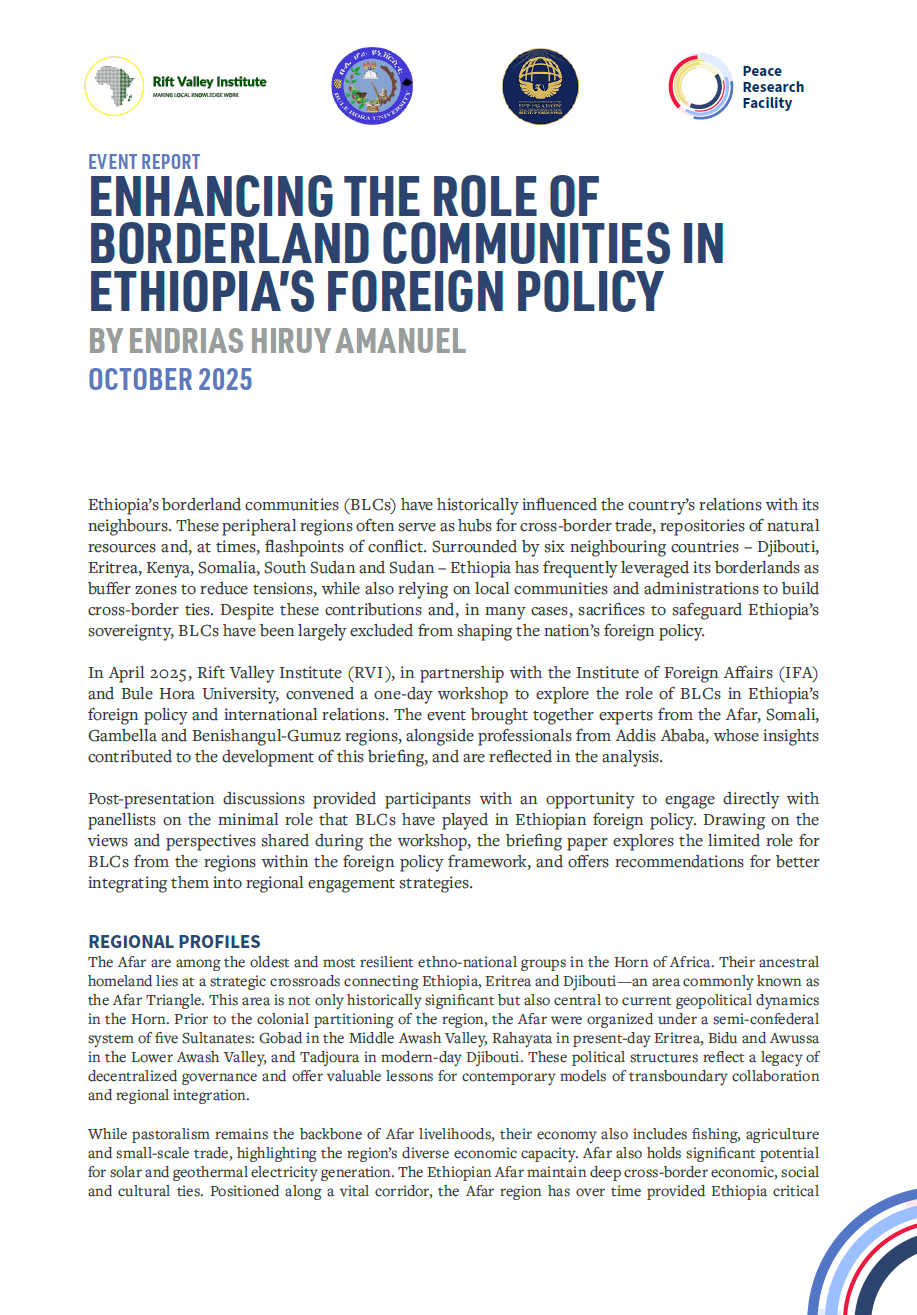Key points
-
Meles was instrumental in the political and developmental changes Ethiopia has undergone in the last two decades.
-
The ruling EPRDF was boosted by the out-pouring of national grief on Meles’ death and Hailemariam Desalegn succeeded him as Prime Minister without controversy.
-
There have been as yet no discernible shifts in government policy since the death of Meles, but this could change as a collective leadership style emerges.
-
Meles was the driving force behind the promotion of IGAD as the model for regional cooperation and the primary channel for diplomacy and security and its influence could be affected by his death.
-
The new Ethiopian leadership appears more willing to engage with the Federal Government of Somalia but the news cordial relationship needs to be institutionalized.
Participants
Tobias Hagmann, Roskilde University, Denmark, and RVI Fellow (Chair)
Asnake Kefale, Addis Ababa University, Ethiopia
Sally Healy, Independent analyst and RVI Fellow
Ibrahim Farah, University of Nairobi, Kenya
Introduction
The death of Ethiopian Prime Minister Meles Zenawi in August 2012 marked the beginning of the end of a generation of ‘reform rebels’ that came to power in East Africa in the 1990s. Prime Minister from 1995 until his death, Meles’ political influence within Ethiopia and the East Africa region was significant. A formidable intellect and at one time the face of a heralded African renaissance, he became a key ally of the West in the global war on terrorism.
Six months after his death, it is an appropriate time to reflect on his legacy, both in Ethiopia and the broader region, to assess progress in the post-Meles political transition, and to weigh the implications for relations with Eritrea, Kenya, Sudan, and South Sudan, and for state-building in Somalia.
The Meles legacy
Opening the forum, the event chair, Tobias Hagmann, began by detailing three different strands of Meles’ legacy, which the panellists would address. Firstly, as Prime Minister, Meles was the driving force behind politics in Ethiopia, the architect of a system of ethnic federalism, and the leader of the ruling Ethiopian Peoples’ Revolutionary Democratic Front (EPRDF). Hagmann asked whether Meles, a charismatic and influential character, had effectively still been governing Ethiopia from the grave?
Secondly, the Meles legacy has had an impact on Ethiopia’s relationships with her neighbours and the politics of the Horn, particularly in the form of IGAD, which has become a critical diplomatic forum for conflict resolution, in large part due to his direction and initiative. Lastly, having played a central role in propagating and implementing the idea of the ‘developmental state’, Meles died leaving Ethiopia as one of the darlings of the international donor community and the recipient of huge sums of foreign aid. What signs have emerged in the last six months that the new leadership in Ethiopia is breaking from or continuing with Meles’ policies in the domestic, regional and international arenas?
National development
Asnake Kefale addressed the question of Meles’ record within Ethiopia. While recognizing that opinion on his legacy is divided, Kefale argued, few dispute that Meles was pivotal in effecting many of the tremendous changes undergone by Ethiopia in the last 20 years. The introduction of a system of ethnic federalism, vast improvements in infrastructure, and the expansion of education and health services are all positively attributed to the leadership of Meles Zenawi. Then again, critics question the record of democratization in Ethiopia, arguing that stability has been pursued over political pluralism and freedom of speech.
In terms of the succession and the way it was managed, Kefale recalled widespread anxiety and concern over the risks of inter-elite competition and instability in a political vacuum left by Meles. But, Kefale suggested, the EPRDF seized upon the out-pouring of national grief to strengthen and shore up the ruling party’s legitimacy, and Hailemariam Desalegn was able to succeed as Prime Minister without controversy. Speculating about the nature of the political transitions taking place, Kefale perceived early signs that a style of collective leadership is re-emerging, characterized by greater consultation and consensus building.
This style of governance, he added, disappeared after the 2000 split in the Tigrayan People’s Liberation Front when Meles’ paramount position was solidified. Dangers in collective leadership include elite competition and inefficiency. But thus far there have been no discernible shifts in government policy since the death of Meles. As the country continues to make the transition from a Meles-dominated era, however, changes in leadership style and structure are inevitable.
Foreign policy
Addressing Meles Zenawi’s record in matters of foreign policy, Sally Healy remarked that while success in this field is difficult to measure, Meles undoubtedly made a distinct impact both regionally and on the international scene. He was able to identify and exploit particular trends that emerged in the last two decades, she argued, specifically post-Cold War regionalism and the restoration of aid and international attention to Africa. While he didn’t create these trends, they were waves he rode to his own and Ethiopia’s advantage.
Over the last 20 years, new approaches have emerged to resolve longstanding tensions and conflicts in the Horn of Africa. Meles was the driving force behind the promotion of IGAD as the paramount vehicle for regional diplomacy and for addressing security concerns. IGAD has become an international model for regional cooperation, credited with being the “midwife” to the independence of South Sudan and the creation of the African Union Mission in Somalia, AMISOM.[1] While it is no coincidence that IGAD’s priorities match Ethiopia’s diplomatic interests, such a regional approach has nonetheless produced notable successes, Healy argued. Meles repositioned Ethiopia, both within the region and within the paradigm of international development. He capitalized on renewed interest in Africa in the early 1990s and the newfound preference on the part of donors for countries with strong governments to address high levels of poverty. Ethiopia became the donors’ darling, receiving substantial aid sums that in turn produced impressive growth figures.
Healy concluded by speculating how these relationships—with the region and with the donor community—will be managed in the absence of Meles. If the collective leadership that Kefale described is less decisive, it is possible that Ethiopia’s role in the region may diminish. Tensions between Ethiopia and Eritrea could reignite if the current leadership proves unable to contain its neighbour without resort to arms, as Meles had done since the end of the war in 2000. Meles’ successors may not be as effective at negotiating aid from the international community, Healy added, or at challenging the so-called ‘Washington consensus’—but short of an escalation of human rights abuses that the donor community would be unable to ignore, it is likely that Ethiopia will remain a highly attractive recipient of foreign aid.
Ethiopia and Somalia
Continuing the theme of foreign policy, Ibrahim Farah considered the implications of Meles’ death for relations between Ethiopia and Somalia. He outlined the different modes of engagement tried by the late prime minister in Somalia during different periods of his rule. First, Farah recalled, there was a period of constructive engagement in the early 1990s, typified by the 1993 Addis Ababa Conference on National Reconciliation in Somalia, at which Meles was instrumental in bringing Somali leaders together. The mid to late 1990s witnessed a more offensive approach, evident in the incursion of Ethiopian troops into Somalia in 1996 and 1997, and the strategic engagement with particular factions in western Somalia. After this, from 2000 onwards, Meles pursued a policy of containment, which broke down between 2006-9 when Ethiopian forces fought alongside the Transitional Federal Government against Islamists within Somalia.
Farah suggested that some changes in Ethiopia’s policy towards Somalia could be discerned since August 2012. He suggested that the new Ethiopian leadership is perhaps more willing to engage with the Federal Government of Somalia, and that Prime Minister Hailemariam Desalegn benefits from not carrying the same historical baggage that Meles did.
It was reported that since the election of President Hassan Sheikh Mohamud, the two leaders have demonstrated a high degree of cooperation and communication. This cordial relationship needs to be institutionalized across both governments, Farah argued. Given historical animosities however, it is questionable whether Ethiopia is in a position to play a constructive role in state-building in Somalia. To reconfigure relations between the two neighbours will be a challenge for both leaders. Hagmann asked what the key steps would be in restructuring this bilateral relationship. In reply, Farah suggested that both governments would need to cooperate on security sector reform and be willing to open the Pandora’s box that was discussion of the Ogaden.
Discussion and audience questions
In discussion, Hagmann reflected upon Meles’ international reputation; frequently praised for his intellect and integrity, and rarely criticized for his role in consolidating an authoritarian state. He asked whether the donor community was likely, in time, to re-evaluate his performance and legacy. Healy supposed that assuming Ethiopia continues to grow and does not develop a reputation for corruption then it will, in all likelihood, remain popular with donors. As for whether democratic processes are likely to re-start in the near future, the panel speculated on a number of scenarios. Perhaps a system of party primaries will be introduced, or multi-party elections held, but for now it is too early to predict the direction of the current political transition.
The debate was opened to include questions from the floor, focusing on Ethiopia’s position and engagement with her neighbours. Participants discussed prospects for improvements in Ethiopian/Eritrean relations; the impact of Kenya’s incursion into Somalia on Ethiopian/Kenyan relations; and the positive patterns of economic co-operation developing between Ethiopia and Somalia. The future for regional integration remains uncertain, one participant commented, given institutional weaknesses within IGAD and the East African Community. For now, the merging of trade blocs across the continent seems like a distant dream. Closing the forum, Hagmann reflected that Meles’ sudden death had demonstrated once again that however good the analysis, major political developments are often unforeseen.
Notes
[1] Paul D. Williams, ‘AMISOM in Transition: The Future of the African Union Mission in Somalia’ (RVI Nairobi Forum Briefing Paper No. 1), 13 February 2013.




